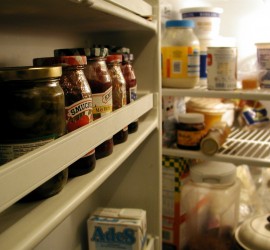Food Safety During a Power Outage

None of us like wasting food. It’s like throwing money down the drain. Have you ever faced a power outage and wondered if the food in your refrigerator is safe to eat? You don’t want to throw away the week’s worth of groceries you just purchased, but you certainly don’t want to risk getting sick. Luckily there great food safety resources that can help us make good decisions when faced with a power outage.
The USDA’s Food Safety website has useful information on how you can prepare for a power outage, how to handle food during the outage, and what to do afterwards. The following are some tips for preparing for an outage:
- Keep an appliance thermometer in both the refrigerator and freezer. Make sure the refrigerator temperature is at 40 °F or below and the freezer is at 0 °F or below.
- Group foods together in both the refrigerator and freezer. This helps foods stay cold longer.
- Keep the freezer full. Fill empty spaces with frozen plastic jugs of water, bags of ice, or gel packs.
- Freeze refrigerated items that you may not need immediately, such as leftovers, milk, and fresh meat and poultry. This will keep them at a safe temperature longer.
- Have a large, insulated cooler and frozen gel packs available. Perishable foods will stay safe in a refrigerator only 4 hours.
- Find out where dry ice and block ice can be purchased.
Click here, to find other tips from the Food and Safety Service on how to handle food during the power outage and guidelines for which foods to keep and toss after power returns.
Another great resource is North Carolina Cooperative Extension’s Disaster website. On the website, you’ll find a handbook called Your Guide to Preparing for Emergencies, which also includes information about food safety during a power outage. You may want to print a copy of the guide to keep in your emergency supply kit as a reference. The handbook includes useful charts that tell you which items in your refrigerator and freezer are safe to keep.
When it comes to food safety, there’s one tip to keep in mind: when in doubt, throw it out. It always better to be on the safe side. But with these resources, you’ll be able to prepare for a power outage in advance and make smart decisions that can help save your groceries and your money!
Make sure to check out our recent blog about emergency preparation for more tips – Be Prepared: Make sure you have an emergency supply of food and water.
Leave a Reply